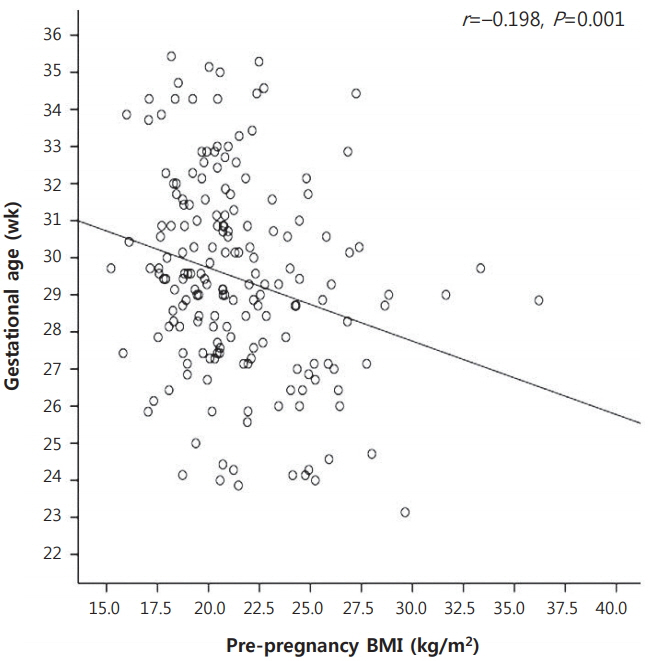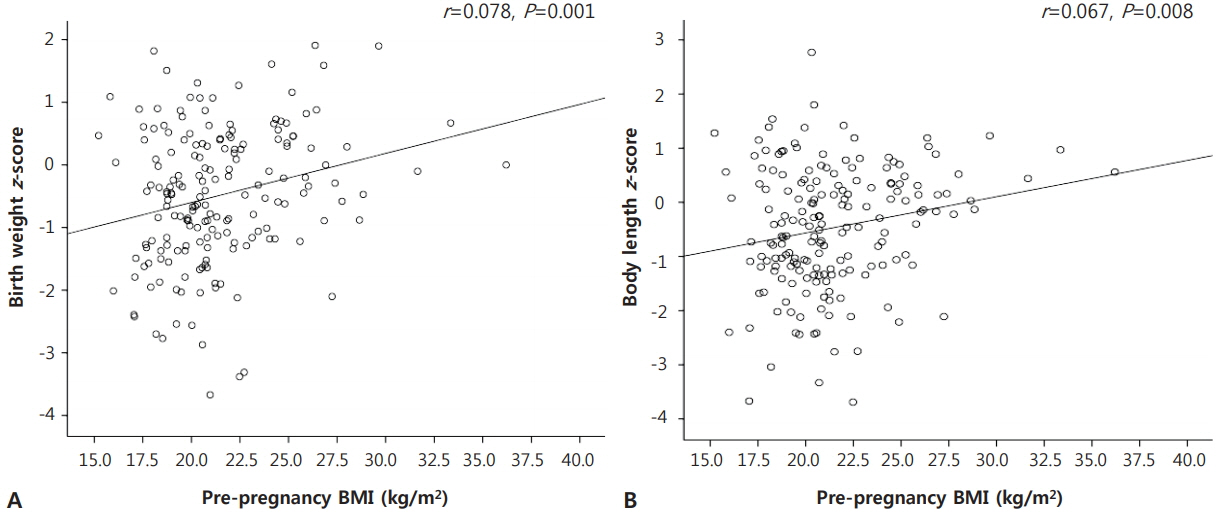Neonatal Med.
2018 Aug;25(3):118-125. 10.5385/nm.2018.25.3.118.
The Effect of Maternal Pre-pregnancy Body Mass Index on Very Low Birth Weight Infants
- Affiliations
-
- 1Department of Pediatrics, CHA Gangnam Medical Center, CHA University School of Medicine, Seoul, Korea. wnslatjsanf@hanmail.net
- KMID: 2436128
- DOI: http://doi.org/10.5385/nm.2018.25.3.118
Abstract
- PURPOSE
The pre-pregnancy body mass index (BMI) is associated with adverse neonatal outcomes. However, studies on very low birth weight (VLBW) infants are rare. This study aimed to investigate the effect of maternal pre-pregnancy BMI on VLBW infants.
METHODS
This retrospective study evaluated singleton VLBW infants born at the CHA Gangnam Medical Center from 2006 to 2016. The neonates were classified into three groups according to the maternal pre-pregnancy BMI: underweight ( < 18.5 kg/m2), normal weight (≥18.5 to < 23 kg/m2), and overweight or obese (≥23 kg/m2). Clinical characteristics and morbidities of mothers and infants were analyzed.
RESULTS
A total of 181 infants belonging to underweight (16.6%), normal weight (58.6%), and overweight or obese (24.8%) groups were enrolled. The pre-pregnancy BMI had a significant negative correlation with gestational age (r=−0.198, P=0.001) and a significant positive correlation with the z-score of the birth weight (r=0.078, P=0.001) and body length (r=0.067, P=0.008). The number of extremely preterm infants was significantly higher in the overweight or obese group. The proportion of risk of small for gestational age infants was higher in the underweight group (adjusted odds ratio [OR], 2.958; 95% confidence interval [CI], 1.113 to 7.864), whereas that of infants with severe retinopathy of prematurity was higher in the overweight or obese group (adjusted OR, 9.546; 95% CI, 1.230 to 74.109).
CONCLUSION
In our population of VLBW infants, the pre-pregnancy BMI was associated with gestational age, intrauterine growth, and adverse neonatal outcomes. Therefore, proper weight control before pregnancy is important.
MeSH Terms
Figure
Reference
-
1. Dzakpasu S, Fahey J, Kirby RS, Tough SC, Chalmers B, Heaman MI, et al. Contribution of prepregnancy body mass index and gestational weight gain to adverse neonatal outcomes: population attributable fractions for Canada. BMC Pregnancy Childbirth. 2015; 15:21.2. Shin D, Song WO. Prepregnancy body mass index is an independent risk factor for gestational hypertension, gestational diabetes, preterm labor, and small- and large-for-gestationalage infants. J Matern Fetal Neonatal Med. 2015; 28:1679–86.3. Flenady V, Koopmans L, Middleton P, Froen JF, Smith GC, Gibbons K, et al. Major risk factors for stillbirth in high-income countries: a systematic review and meta-analysis. Lancet. 2011; 377:1331–40.4. McDonald SD, Han Z, Mulla S, Beyene J; Knowledge Synthesis Group. Overweight and obesity in mothers and risk of preterm birth and low birth weight infants: systematic review and metaanalyses. BMJ. 2010; 341:c3428.5. Han Z, Mulla S, Beyene J, Liao G, McDonald SD; Knowledge Synthesis Group. Maternal underweight and the risk of preterm birth and low birth weight: a systematic review and metaanalyses. Int J Epidemiol. 2011; 40:65–101.6. Heaman M, Kingston D, Chalmers B, Sauve R, Lee L, Young D. Risk factors for preterm birth and small-for-gestational-age births among Canadian women. Paediatr Perinat Epidemiol. 2013; 27:54–61.7. Bruno CJ, Locke R, Mackley A, Paul DA. The association between maternal body mass index and severity of neonatal illness in very low birth weight infants. J Matern Fetal Neonatal Med. 2009; 22:560–4.8. World Health Organization Western Pacific Region; International Association for the Study of Obesity. International Obesity Task Force. The Asia-Pacific perspective: redefining obesity and its treatment. Sydney: Health Communications Australia Pty Limited;2000.9. Fenton TR, Kim JH. A systematic review and meta-analysis to revise the Fenton growth chart for preterm infants. BMC Pediatr. 2013; 13:59.10. Bell MJ, Ternberg JL, Feigin RD, Keating JP, Marshall R, Barton L, et al. Neonatal necrotizing enterocolitis. Therapeutic decisions based upon clinical staging. Ann Surg. 1978; 187:1–7.11. Jobe AH, Bancalari E. Bronchopulmonary dysplasia. Am J Respir Crit Care Med. 2001; 163:1723–9.12. Papile LA, Burstein J, Burstein R, Koffler H. Incidence and evolution of subependymal and intraventricular hemorrhage: a study of infants with birth weights less than 1,500 gm. J Pediatr. 1978; 92:529–34.13. The International Committee for the Classification of the Late Stages of Retinopathy of Prematurity. An international classification of retinopathy of prematurity. II. The classification of retinal detachment. Arch Ophthalmol. 1987; 105:906–12.14. Chu SY, Callaghan WM, Kim SY, Schmid CH, Lau J, England LJ, et al. Maternal obesity and risk of gestational diabetes mellitus. Diabetes Care. 2007; 30:2070–6.15. Ovesen PG, Jensen DM, Damm P, Rasmussen S, Kesmodel US. Maternal and neonatal outcomes in pregnancies complicated by gestational diabetes. a nation-wide study. J Matern Fetal Neonatal Med. 2015; 28:1720–4.16. Santangeli L, Sattar N, Huda SS. Impact of maternal obesity on perinatal and childhood outcomes. Best Pract Res Clin Obstet Gynaecol. 2015; 29:438–48.17. Sung SJ, Lee SM, Kim S, Kim BJ, Park CW, Park JS, et al. The risk of spontaneous preterm birth according to maternal prepregnancy body mass index in twin gestations. J Korean Med Sci. 2018; 33:e103.18. Cnattingius S, Villamor E, Johansson S, Edstedt Bonamy AK, Persson M, Wikstrom AK, et al. Maternal obesity and risk of preterm delivery. JAMA. 2013; 309:2362–70.19. Al-Obaidly S, Parrish J, Murphy KE, Maxwell C. Maternal pre-gravid body mass index and obstetric outcomes in twin gestations. J Perinatol. 2014; 34:425–8.20. Gregor MF, Hotamisligil GS. Inflammatory mechanisms in obesity. Annu Rev Immunol. 2011; 29:415–45.21. Aye IL, Lager S, Ramirez VI, Gaccioli F, Dudley DJ, Jansson T, et al. Increasing maternal body mass index is associated with systemic inflammation in the mother and the activation of distinct placental inflammatory pathways. Biol Reprod. 2014; 90:129.22. Christian LM, Porter K. Longitudinal changes in serum proinflammatory markers across pregnancy and postpartum: effects of maternal body mass index. Cytokine. 2014; 70:134–40.23. Nohr EA, Vaeth M, Baker JL, Sorensen TIa, Olsen J, Rasmussen KM. Combined associations of prepregnancy body mass index and gestational weight gain with the outcome of pregnancy. Am J Clin Nutr. 2008; 87:1750–9.24. Yu Z, Han S, Zhu J, Sun X, Ji C, Guo X. Pre-pregnancy body mass index in relation to infant birth weight and offspring overweight/obesity: a systematic review and meta-analysis. PLoS One. 2013; 8:e61627.25. Abenhaim HA, Kinch RA, Morin L, Benjamin A, Usher R. Effect of prepregnancy body mass index categories on obstetrical and neonatal outcomes. Arch Gynecol Obstet. 2007; 275:39–43.26. Zhang B, Yang S, Yang R, Wang J, Liang S, Hu R, et al. Maternal prepregnancy body mass index and small for gestational age births in Chinese women. Paediatr Perinat Epidemiol. 2016; 30:550–4.27. Sridhar SB, Xu F, Hedderson MM. Trimester-specific gestational weight gain and infant size for gestational age. PLoS One. 2016; 11:e0159500.28. Pai VV, Carmichael SL, Kan P, Leonard SA, Lee HC. Maternal body mass index and risk of intraventricular hemorrhage in preterm infants. Pediatr Res. 2018; 83:1146–51.29. Pantham P, Aye IL, Powell TL. Inflammation in maternal obesity and gestational diabetes mellitus. Placenta. 2015; 36:709–15.30. Segovia SA, Vickers MH, Gray C, Reynolds CM. Maternal obesity, inflammation, and developmental programming. Biomed Res Int. 2014; 2014:418975.31. Oben JA, Mouralidarane A, Samuelsson AM, Matthews PJ, Morgan ML, McKee C, et al. Maternal obesity during pregnancy and lactation programs the development of offspring non-alcoholic fatty liver disease in mice. J Hepatol. 2010; 52:913–20.32. Holm M, Morken TS, Fichorova RN, VanderVeen DK, Allred EN, Dammann O, et al. Systemic inflammation-associated proteins and retinopathy of prematurity in infants born before the 28th week of gestation. Invest Ophthalmol Vis Sci. 2017; 58:6419–28.33. Institute of Medicine and National Research Council. Weight gain during pregnancy: reexamining the guidelines. Washington, DC: The National Academies Press;2009.
- Full Text Links
- Actions
-
Cited
- CITED
-
- Close
- Share
- Similar articles
-
- The Association of Maternal Body Mass Index with Birth Weight and Cesarean Delivery
- Determinants of Infant Birthweight
- The Effect of Prepregnancy Body Mass Index and Weight Gain during Pregnancy on Infant Birth Weight
- Prepregnancy weight, maternal weight gain, and birth weight
- Maternal Body Characteristics and Birth weight of Fullterm Infants



